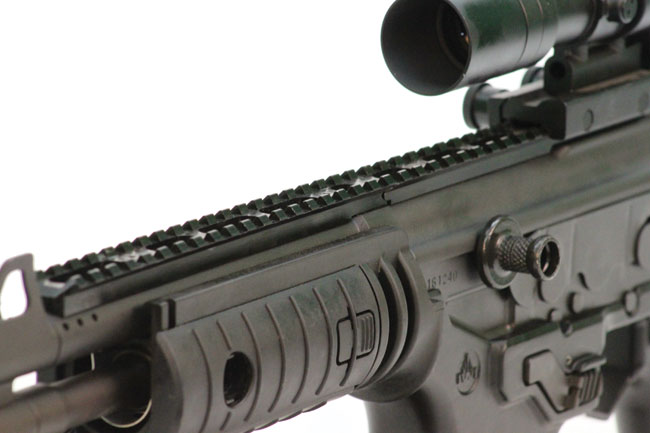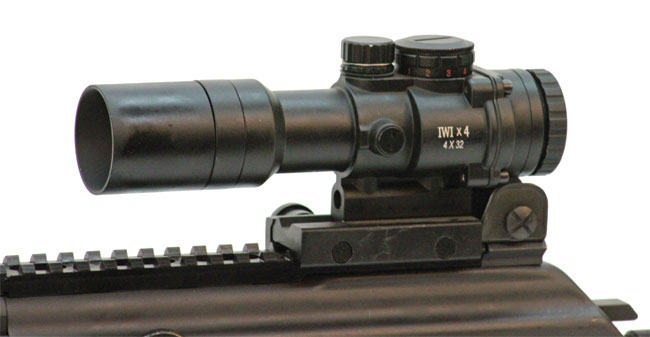Receiver and Trigger group
The receiver is made in mixed materials: high resistance steel and polymer. The upper part has been inherited from the classic Galil, and it has been built from a steel bar carefully machined with CNC machine tools. Just to give an idea, after the field strip of the rifle we looked inside the receiver ad we could hardly discover tool marks.
The upper part machining work creates inside the rails where the BCG runs at each shot, the feeding ramp, the notches that engage the spring rod disassembly button and the top cover, made in stamped steel, in a steady way.
In particular the top cover accommodates another portion of the top Picatinny rail and the rear iron sight, an aperture system identical to the one of the M16A1, very familiar in the IDF. The apertures are on two L shaped flip-up leaves, that can be selected according to the range of the target: one is for closer range engagements (0-150 m) one is for distant range engagement (up to 300 m).
The lower part of the receiver has been made in strong black polymer, molded and permanently attached to the steel upper part to decrease the weight of the weapon.
The polymer part includes the pistol grip, the trigger guard and the magazine well.
On the right side of the Galil ACE we find the safety/fire selector in the same position of the AK47, marked, from top down, “S” for “Safety”, “A” for “Auto” (full auto fire) and “R” for “Repetition” (Semiauto fire), adopting the same sequence of selection of the Russian assault rifle. The lever, anyway, has been reduced in size, since it is NOT required to act as dust cover on the groove after the ejection port. A little bit forward, but lower, at the edge of line where the polymer and steel meet, there is the round button of the hold-open, easily reachable with the index of the right hand. This marks one of the differences with the Russian firearms and of the old Galil: after the last round the Galil bolt remains open, warning the shooter that the magazine is empty. Once replaced with a fully loaded mag, just a downward pressure and the shooting action can be resumed any time.
On the left side we found the charging handle protruding from the receiver. On this side the receiver has been modified, to allow the shooter to operate the bolt without using the hand on the pistol grip, or rotating the weapon or, like in the original Galil version, putting palm of the left hand across and above the receiver, all operations that temporarily obstruct the rifle sights.
This required a long gap between the top cover and the left edge of the receiver, with consequent possible exposition of the firearm interior to sand, dust and dirt.
The problem has been solved with a sliding vertical stamped metal side cover, kept in position by a couple of springs, and with rounded shape at each end. When the pin of the charging handle goes backward, it hits the forward round edge of the cover, forcing it down at each cycle., When the charging handle returns forward, and the bolt goes in battery, the side cover goes up, pushed by the springs, closing the gap between the top cover and the receiver and so doing protecting the mechanism of the Galil from dirt.
On the left side, just above the pistol grip, there is another safety/ fire selector, but this time operated by the shooter’s thumb: it’s a relay of the safety/fire selector Kalashnikov-style we found on the other side (a feature also on the original Galil…) with pictograms punched on it indicating the three possible fire options.
The trigger group is modeled after the AK47, with the hammer operated by a robust and powerful steel twisted double wire spring.
Normally the magwell accommodates proprietary 35 round Galil magazines, the mag catch and related release button are in central position like in the AK47, to be used by both right-handed and left-handed shooters.
We found out that the ultimate Galil ACE version uses standard M16 30-rounds mags: magwell and related mag catch have been redesigned to accommodates ambidextrous mag release buttons M16 style, simplifying the logistics due to the huge amount of M16 magazines available in IDF depots and the large availability of compatible M16 mags around the world.

The pistol grip is also in polymer, of generous dimensions and with some checkerings to offer a better grip holding the Galil ACE even with gloved hands. The hollow interior of the pistol grip is a storage compartment for batteries, small rifle cleaning kit or whatever the shooter needs to have ready at hand. The compartment in the pistol grip is closed at the bottom by a practical hermetic lid hinged to the bottom-back of the grip.
Stock and Front Handguard
Another innovation came from the stock: the 5.56 versions do not use the typical steel skeleton folding stock anymore.
IWI opted for a collapsible stock with cheek piece in polymer, with no rubber buttstock.
This solution saves further total weight, because the only metal part left is the central tube attached with metallic plate to the end of the receiver, and allows adapting the rifle length in case the operator is wearing body armor.
The front handguard is made with fiber loaded polymer, with little protruding ribs to give the proper grip to the shooter’s hands. They can be removed to have access to other Picatinny rails on the bottom of the front handguards, offering further points to mount anything needed to accomplish successfully a mission.
Test Range
The test range took place in IWI facilities, at Ramat Ha’Sharon, Israel.
The range was the short distance range, with max shooting distance of 25 meter, and thus unsuitable to evaluate accuracy in meditated slow rate shooting.
We tested the Galil ACE 22, 13” barrel length, equipped with an IWI 4×32 optic with illuminated reticle that worked unexpectedly well at short range.
After an initial briefing with IWI instructors, we handled the rifle without ammo to take confidence and make some preliminary evaluations.

If you are familiar with the M16, the selector lever positions will give you some problems: “Think Kalashnikov” was the statement the range instructors repeated when we found ourselves lost with the fire mode we wanted to select.
Despite this, the general ergonomics of the Galil ACE is satisfactory: the balance is shifted toward the barrel, as in the classic configuration rifles like M4 or M16, and this helps to control the rifle in rapid fire or when executing full auto shooting.
The thumb selector (we never used the lever on the other side…) is comfortable if you have to switch from safe to full auto. It requires you to slightly modify the position of your right hand on the pistol grip if you want to switch in semiauto mode, while it is a bit uncomfortable if, after a shooting action, you want to put the weapon on the safety.
The trigger is large and smooth, made to be used with the articulation of the first phalanx of the index finger wrapped around it. This means “full auto,” because this kind of trigger configuration does not help with semiauto shooting. The first position of the selector is full auto, so it is logical.
Inserting mags makes you feel comfortable if you are used to the M16 style rifle, as well as changing an empty magazine, while it takes a little at the beginning is to find the hold-open button, which is on the opposite side of the American rifle: you need to remember each time, after you slap a loaded magazine in place, to extend your right hand index finger and press down the round button just above the trigger. Nothing that a good training of your muscular memory can’t fix.
The reciprocating charging handle on the left side of the receiver, FN FAL style, is big, comfortable and instinctive to operate, allowing you to speed up chambering the first round after a mag change without losing the sights.
If you expect that the metal spring actuated sliding side cover will give reliability problems when shooting you’re wrong: after shooting several mags in full auto, the metal cover was still in its place, protecting the sturdy Galil mechanics hidden in the interior of the receiver.
The cheek-mold of the stock is comfortable, due to the cheekpiece, and guides you to easily acquire and keep the correct position to look through the mounted optic.
The test started in semiauto mode, just to gain confidence with the trigger, at first with meditated shooting, then executing fast double taps.
The trigger is really smooth, with a long first stage before hammer release. This last one is not a clean and sharp one, in perfect Kalashnikov tradition, but warns you when the hammer is going to be released.
The hammer release is sweet and despite the trigger overtravel does not induce the shooter to any parasite movement that can negatively affect accuracy.
Double taps revealed that Galil has the tendency to raise the muzzle a little, but positioning shoulder and grip in the right way the carbine became fully controllable also when shooting fast in semiauto mode.
Magazine change, thanks to the new mag release buttons, is as fast as in a M16 style rifle.
The pistol grip allows you a firm grip, as expected, with gloved hands.
With the exception of the trigger, all the commands on the rifle must be operated with decision to get what you want, especially the safety/fire selector.
When switched to full auto, the weight balance shifted toward the barrel end and the new gripping position on the carbine we found out, with the right shoulder a little bit raised and the cheek pressing more the cheekpiece, paid the effort, and the Galil ACE, even after the polymer weight-watcher diet, results to be controllable shooting two, three and five rounds bursts.
We were able to put five round bursts in the head of our target in groups no larger than a man’s fist.
Conclusions
Lighter than the old version, reliable, robust, flexible, Galil ACE, thanks to the continuous efforts by IWI engineers to improve it, deserves all these adjectives.
Full length rails and polymers usage in the rifle structure allow this mid ‘70s Israeli creation to be on the battlefield in years to come, especially for those armies whose weapon of choice by operators that are familiar with the legendary reliability and sturdiness of the Galil and that don’t want to renounce to any of them.
Manufacturer: Israel Weapon Industries (IWI) Ltd. 64 Bialik Blvd. PO Box 63, Ramat Hasharon 47100 Israel; www.israel-weapon.com
Model: Galil ACE 21, 22, 23
Type: selective fire carbine/rifle
Rate of fire: 700 rounds per minute
Caliber: 5.56 x 45 (M193 od M855)
Action: Rotating bolt, gas operated by long stroke piston
Barrel: chrome lined, 6 RH 1:7 twist, lenght 215 mm (8.45” ACE 21) 332 mm (13” ACE 22) 460 mm (18” ACE23)
Magazine: STANAG 4179 30 rounds mag
FCG: Internal hammer, single action, selective fire (safety, full auto, semiauto positions); closed bolt design
Sights: Front post, rear aperture, optionals any optronic/optic sights with Picatinny mounts
Materials: Body: Steel and reinforced UV and impact resistant injection molded technopolymer.
Length (extended stock): 730 mm (ACE 21) 847 mm (ACE 22) 975 mm (ACE 23)
Length (retracted stock): 650 mm (ACE 21) 767 mm (ACE 22) 895 mm (ACE 23)
Muzzle velocity: 710 m/s (ACE 21) 850 m/s (ACE 22) 915 m/s (ACE 23)
Weight (w/o magazine): 2950 gr (ACE 21) 3250 gr (ACE 22) 3400 gr (ACE 23)









